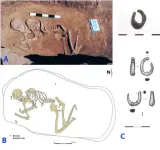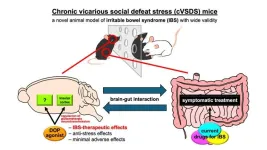(Press-News.org) Antibiotics are indispensable for treating bacterial infections. But why are they sometimes ineffective, even when the bacteria are not resistant? In their latest study published in the journal Nature, researchers from the University of Basel challenge the conventional view that a small subset of particularly resilient bacteria are responsible for the failure of antibiotic therapies.
In certain infectious diseases caused by bacteria, antibiotics are less effective than expected. One example is infections caused by Salmonella bacteria, which can lead to illnesses such as typhoid fever. For many years, researchers believed that a small subset of dormant bacteria are the main problem in fighting infections. These so-called persisters can survive antibiotic treatment and cause relapses later. Researchers worldwide have been working on new therapies aimed at targeting and eliminating these “sleeping” bacteria.
In a new study, Professor Dirk Bumann’s team from the Biozentrum of the University of Basel challenges the prevailing concept that persisters are the cause of antibiotic ineffectiveness. “Contrary to widespread belief, antibiotic failure is not caused by a small subset of persisters. In fact, the majority of Salmonella in infected tissues are difficult to kill,” explains Bumann. “We have been able to demonstrate that standard laboratory tests of antimicrobial clearance produce misleading results, giving a false impression of a small group of particularly resilient persisters.”
Nutrient starvation increases Salmonella resilience
The researchers investigated antimicrobial clearance in both Salmonella-infected mice and tissue-mimicking laboratory models. The body’s defense mechanisms against bacteria often include reducing the availability of nutrients. The researchers have now revealed that in fact, this nutrient starvation is the main reason for Salmonella bacteria surviving treatments with antibiotics. The researchers assume that the same applies to other bacterial pathogens.
“Under nutrient-scarce conditions, bacteria grow very slowly,” says Bumann. “This may seem good at first, but is actually a problem because most antibiotics only gradually kill slowly growing bacteria.” As a result, the drugs are much less effective, and relapses can occur even after prolonged therapy.
Real-time analyses reveal misconception
The scientists used an innovative method to monitor antibiotic action in single bacteria in real time. “We demonstrated that nearly the entire Salmonella population survives antibiotic treatment for extended periods, not just a small subset of hyper-resilient persisters,” says Dr. Joseph Fanous, the study’s first author.
A major issue with the standard methods used worldwide for decades is their indirect and delayed measurement of bacterial survival, leading to distorted results. “Traditional tests underestimate the number of surviving bacteria,” explains Fanous. “And they falsely suggest the presence of hyper-resilient subsets of persisters that do not actually exist.” This misinterpretation has influenced research for many years.
Novel tools for antibiotics research
These findings could fundamentally change antibiotics research. “Our work underlines the importance of studying bacterial behavior and antibiotic effects live and under physiologically relevant conditions,” emphasizes Bumann. “In a few years, modern methods like real-time single-cell analysis will hopefully become standard.” Shifting the focus from persisters to the impact of nutrient starvation is an important step toward more effective therapies against difficult-to-treat infections.
The project is part of the National Center of Competence in Research (NCCR) “AntiResist”. The research consortium aims to develop innovative strategies to combat bacterial infections. Dirk Bumann is one of the directors of the NCCR “AntiResist”.
END
Why antibiotics can fail even against non-resistant bacteria
2025-02-05
ELSE PRESS RELEASES FROM THIS DATE:
Missing link in Indo-European languages' history found
2025-02-05
Where lies the origin of the Indo-European language family? Ron Pinhasi and his team in the Department of Evolutionary Anthropology at the University of Vienna contribute a new piece to this puzzle in collaboration with David Reich's ancient DNA laboratory at Harvard University. They analyzed ancient DNA from 435 individuals from archaeological sites across Eurasia between 6.400–2.000 BCE. They found out that a newly recognized Caucasus-Lower Volga population can be connected to all Indo-European-speaking populations. The new ...
Cancer vaccine shows promise for patients with stage III and IV kidney cancer
2025-02-05
Boston – Dana-Farber Cancer Institute researchers report that all nine patients in a clinical trial being treated for stage III or IV clear cell renal cell carcinoma (a form of kidney cancer), generated a successful anti-cancer immune response after initiation of a personalized cancer vaccine. The vaccines were administered after surgery to remove the tumor and are designed to train the body’s immune system to recognize and eliminate any remaining tumor cells. At the time of data cut-off (median of 34.7 months), ...
Only seven out of 100 people worldwide receive effective treatment for their mental health or substance-use disorders
2025-02-05
New research estimates that globally, only 6.9 per cent of people with mental health or substance-use disorders receive effective treatment for their disorders.
Researchers from the University of British Columbia and Harvard Medical School analyzed survey data from nearly 57,000 participants in 21 countries collected over a 19-year period, to provide the clearest picture yet of where people discontinue their path to effective treatment for nine common anxiety, mood and substance-use disorders.
The biggest barrier to effective ...
Ancient engravings shed light on early human symbolic thought and complexity in the levantine middle palaeolithic
2025-02-05
New study demonstrates that certain incised stone artefacts from the Levantine Middle Palaeolithic, specifically from Manot, Qafzeh, and Quneitra caves, were deliberately engraved with geometric patterns, indicating advanced cognitive and symbolic behaviour among early humans. In contrast, artefacts from Amud Cave, with shallow and unpatterned incisions, are consistent with functional use. This research highlights the intentionality behind the engravings, providing key insights into the development of abstract thinking and the cultural complexity of Middle Palaeolithic societies.
Link ...
The sexes have different strengths for achieving their goals
2025-02-05
Many factors are needed to achieve our goals. Now researchers have looked at passion, drive and people’s ability to find flow.
“This is the first study to look at these factors together,"says Professor Hermundur Sigmundsson at the Norwegian University of Science and Technology (NTNU’s) Department of Psychology.
The researchers have found differences between the sexes. The results indicate that the sexes each have their own strengths when it comes to success.
Men are more passionate than women when it comes to achieving their goals. They also often have an easier time finding flow.
Women, ...
College commuters: Link between students’ mental health, vehicle crashes
2025-02-05
Young adults are a higher risk group for being in a crash while driving due likely to inexperience with driving, driving under the influence, and a greater propensity to take risks while driving. Although research has explored sociodemographic links of driver crashes based on age, sex and socioeconomic status, reports on the relationship between crashes and mental health are sparse.
A new Florida Atlantic University study fills a notable gap by exploring the correlation between commuter college students’ mental health status and being in a crash while driving. Commuter students, often lower-income, older, or balancing family responsibilities, face greater ...
Using sugars from peas speeds up sour beer brewing
2025-02-05
Sour beers have become a fixture on microbrewery menus and store shelves. They’re enjoyed for their tart, complex flavors, but some can require long and complicated brewing processes. Researchers reporting in ACS’ Journal of Agricultural and Food Chemistry brewed new sours in less time using a seemingly strange ingredient: field peas. The experimental beers had fruity — not “beany” — flavors and other attributes comparable to a commercial Belgian-style sour, but with shorter, simpler brewing steps.
“Sour beer is the beer enthusiast’s alternative to Champagne. By using sugars derived from peas that yeast ...
Stormwater pollution sucked up by specialized sponge
2025-02-05
Reusable sponge platform has successfully removed oil, phosphate and metal from contaminated water
New development allows capture of valuable minerals and reuse of the sponge
Water pollution concentrations move from 0.8 parts per million to undetectable levels
EVANSTON, Ill. --- As more waterways contend with algae blooms and pollution caused by minerals from agricultural runoff and industrial manufacturing processes, new methods to remove pollutants like phosphate, copper and zinc are emerging across fields.
While solutions exist, they tend to be costly ...
Value-added pancakes: WSU using science to improve nutrition of breakfast staple
2025-02-05
PULLMAN, Wash. — Typical breakfast pancakes are soft, fluffy and delicious but, sadly, not terribly healthy.
Food scientists at Washington State University are working to change that by boosting the popular morning favorite’s nutritional value while enhancing its taste and texture.
“Generally, pancakes are made with refined flours, contributing to empty calories,” said Girish Ganjyal, a professor and food processing specialist in WSU’s School of Food Science. “We wanted to see if it’s ...
Beyond the gut: A new frontier in IBS treatment by targeting the brain
2025-02-05
Irritable bowel syndrome (IBS) is a common digestive disorder that affects the intestine, causing symptoms such as abdominal pain, bloating, gas, and changes in bowel habits, including diarrhea, constipation, or both. Although this condition affects about a tenth of the global population, the underlying causes and mechanisms of IBS remain unclear. Consequently, treatments for IBS primarily focus on managing symptoms rather than addressing the root cause of the disorder.
At Tokyo University of Science ...








